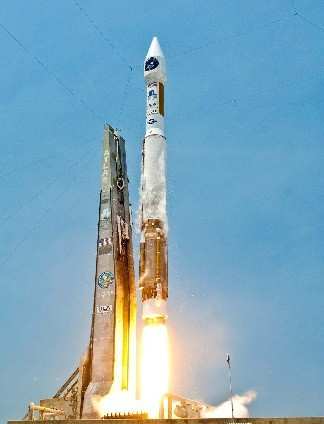Sat, Sep 15, 2012
Integrated Systems Review Proposes CST-100 Spacecraft Boosted By An Atlas V Launch Vehicle
The Boeing Company has completed its first performance milestone for NASA's Commercial Crew Integrated Capability (CCiCap) initiative, which is intended to lead to the availability of human spaceflight transportation services for government and commercial customers. In its Integrated Systems Review (ISR), Boeing presented the latest designs of its CST-100 spacecraft, United Launch Alliance's Atlas V rocket launch system, and ground and mission operations. These designs will serve as the baseline for further development work to be accomplished during CCiCap. The company also discussed its plans for safety and mission assurance, which ultimately will contribute to achieving certification of the system for human spaceflight.

"The ISR established a firm baseline configuration that will allow our team to push forward with the final vehicle design", said John Mulholland, Boeing vice president and program manager for Commercial Programs. "We hope the rigor of our design and development process, and our outstanding team of suppliers will help position the CST-100 as one of the next crew transportation vehicles to the space station and other low Earth orbit destinations."
Technical experts from NASA's Commercial Crew Program (CCP) participated in the review in Houston. They are in the process of providing comments and advice based on more than 50 years of human spaceflight experience.

"All of our industry partners are gearing up to push their human spaceflight technologies further than ever before so America can have its own crew transportation system around the middle of the decade," said Ed Mango, CCP's program manager. "This review was just the first of many exciting and valuable milestones Boeing is expected to complete during its funded partnership with NASA."
At the review, Boeing also presented results from numerous tests that were conducted as part of its earlier Commercial Crew Development Round Two Space Act Agreement with NASA. These tests included parachute and air bag drops, abort engine firings and wind tunnel tests. NASA's new CCiCap agreements follow two previous commercial endeavors by the agency to spur the development of crew transportation systems and subsystems. Work by NASA's industry partners during CCiCap will set the stage for a crewed orbital demonstration mission around the middle of the decade.
Future development and certification initiatives eventually will lead to the availability of human spaceflight services for NASA to send its astronauts to the International Space Station. The overall goal of NASA's commercial space efforts is to make low Earth orbit more accessible and open for business for other government and commercial customers.
(Images Top Boeing CST-100, Bottom ULA Atlas V launch)
More News
States That Current Process is Damaging National Aerospace Development US Senator Jerry Morgan is pushing the FAA to speed up the process for rocket launch licensing. He argues tha>[...]
From 2015 (YouTube Edition): Model Aviator Aims For Full-Scale Career While at the 2015 Indoor Electric RC Festival, referred to as eFest, ANN CEO and Editor-In-Chief, Jim Campbell>[...]
Dave Juwel's Aviation Marketing Stories ITBOA BNITBOB ... what does that mean? It's not gibberish, it's a lengthy acronym for "In The Business Of Aviation ... But Not In The Busine>[...]
Aero Linx: Cardinal Flyers Online The Cardinal Flyers Online Web site was created and is maintained by me, Keith Peterson. My wife Debbie and I have owned a 1976 RG since 1985. Wit>[...]
Clearance Void If Not Off By (Time) Used by ATC to advise an aircraft that the departure release is automatically canceled if takeoff is not made prior to a specified time. The exp>[...]
 Senator Pushes FAA to Accelerate Rocket Launch Licensing
Senator Pushes FAA to Accelerate Rocket Launch Licensing Classic Aero-TV: RJ Gritter - Part of Aviations Bright New Future
Classic Aero-TV: RJ Gritter - Part of Aviations Bright New Future Aero-FAQ: Dave Juwel's Aviation Marketing Stories -- ITBOA BNITBOB
Aero-FAQ: Dave Juwel's Aviation Marketing Stories -- ITBOA BNITBOB ANN's Daily Aero-Linx (10.27.24)
ANN's Daily Aero-Linx (10.27.24) ANN's Daily Aero-Term (10.27.24): Clearance Void If Not Off By (Time)
ANN's Daily Aero-Term (10.27.24): Clearance Void If Not Off By (Time)




